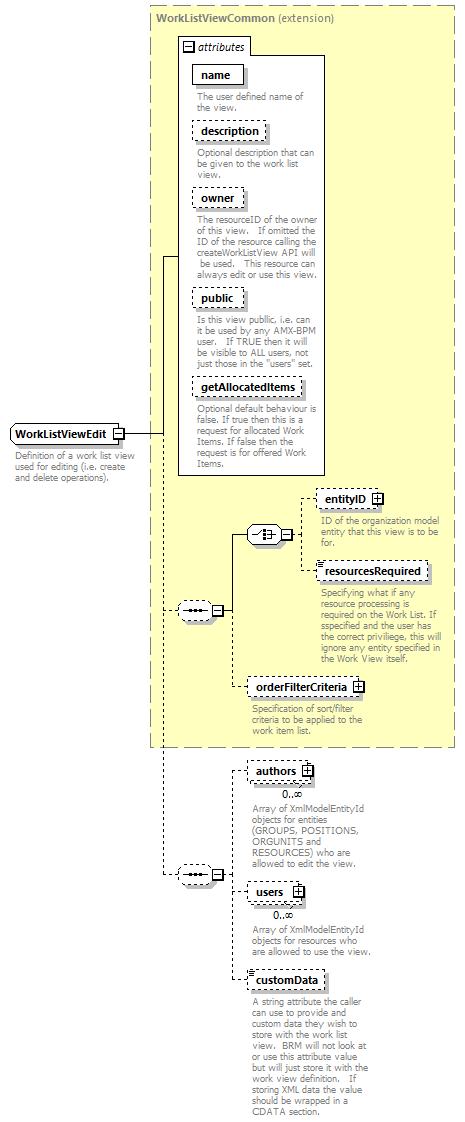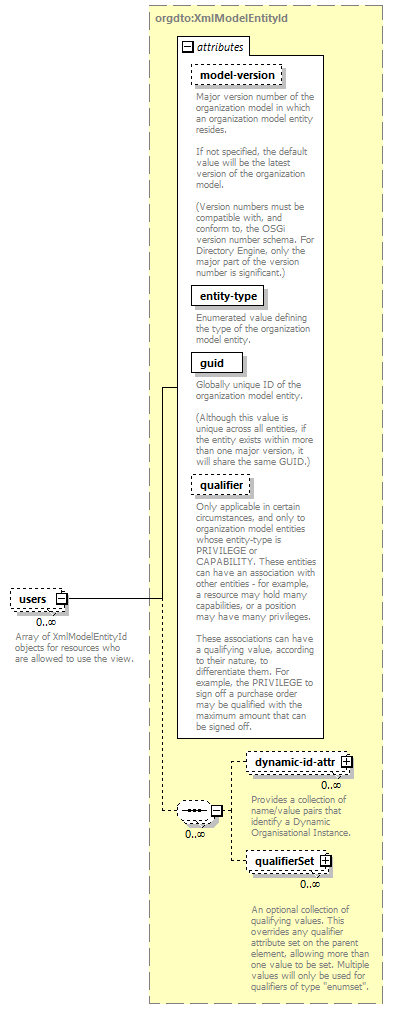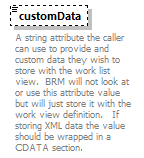| diagram |  |
||||||||||||||||||||||||||||||||||||||||||||||
| namespace | http://api.brm.n2.tibco.com | ||||||||||||||||||||||||||||||||||||||||||||||
| type | extension of WorkListViewCommon | ||||||||||||||||||||||||||||||||||||||||||||||
| properties |
|
||||||||||||||||||||||||||||||||||||||||||||||
| children | entityID resourcesRequired orderFilterCriteria authors users customData | ||||||||||||||||||||||||||||||||||||||||||||||
| used by |
|
||||||||||||||||||||||||||||||||||||||||||||||
| attributes |
|
||||||||||||||||||||||||||||||||||||||||||||||
| annotation |
|
||||||||||||||||||||||||||||||||||||||||||||||
| source | <xs:complexType name="WorkListViewEdit"> <xs:annotation> <xs:documentation>Definition of a work list view used for editing (i.e. create and delete operations).</xs:documentation> </xs:annotation> <xs:complexContent> <xs:extension base="WorkListViewCommon"> <xs:sequence minOccurs="0"> <xs:element name="authors" type="orgdto:XmlModelEntityId" minOccurs="0" maxOccurs="unbounded"> <xs:annotation> <xs:documentation>Array of XmlModelEntityId objects for entities (GROUPS, POSITIONS, ORGUNITS and RESOURCES) who are allowed to edit the view.</xs:documentation> </xs:annotation> </xs:element> <xs:element name="users" type="orgdto:XmlModelEntityId" minOccurs="0" maxOccurs="unbounded"> <xs:annotation> <xs:documentation>Array of XmlModelEntityId objects for resources who are allowed to use the view.</xs:documentation> </xs:annotation> </xs:element> <xs:element name="customData" type="xs:string" minOccurs="0"> <xs:annotation> <xs:documentation>A string attribute the caller can use to provide and custom data they wish to store with the work list view. BRM will not look at or use this attribute value but will just store it with the work view definition. If storing XML data the value should be wrapped in a CDATA section.</xs:documentation> </xs:annotation> </xs:element> </xs:sequence> </xs:extension> </xs:complexContent> </xs:complexType> |
element WorkListViewEdit/authors
| diagram |  |
||||||||||||||||||||||||||||||||||||||
| type | XmlModelEntityId | ||||||||||||||||||||||||||||||||||||||
| properties |
|
||||||||||||||||||||||||||||||||||||||
| children | dynamic-id-attr qualifierSet | ||||||||||||||||||||||||||||||||||||||
| attributes |
|
||||||||||||||||||||||||||||||||||||||
| annotation |
|
||||||||||||||||||||||||||||||||||||||
| source | <xs:element name="authors" type="orgdto:XmlModelEntityId" minOccurs="0" maxOccurs="unbounded"> <xs:annotation> <xs:documentation>Array of XmlModelEntityId objects for entities (GROUPS, POSITIONS, ORGUNITS and RESOURCES) who are allowed to edit the view.</xs:documentation> </xs:annotation> </xs:element> |
element WorkListViewEdit/users
| diagram |  |
||||||||||||||||||||||||||||||||||||||
| type | XmlModelEntityId | ||||||||||||||||||||||||||||||||||||||
| properties |
|
||||||||||||||||||||||||||||||||||||||
| children | dynamic-id-attr qualifierSet | ||||||||||||||||||||||||||||||||||||||
| attributes |
|
||||||||||||||||||||||||||||||||||||||
| annotation |
|
||||||||||||||||||||||||||||||||||||||
| source | <xs:element name="users" type="orgdto:XmlModelEntityId" minOccurs="0" maxOccurs="unbounded"> <xs:annotation> <xs:documentation>Array of XmlModelEntityId objects for resources who are allowed to use the view.</xs:documentation> </xs:annotation> </xs:element> |
element WorkListViewEdit/customData
| diagram |  |
||||||
| type | xs:string | ||||||
| properties |
|
||||||
| annotation |
|
||||||
| source | <xs:element name="customData" type="xs:string" minOccurs="0"> <xs:annotation> <xs:documentation>A string attribute the caller can use to provide and custom data they wish to store with the work list view. BRM will not look at or use this attribute value but will just store it with the work view definition. If storing XML data the value should be wrapped in a CDATA section.</xs:documentation> </xs:annotation> </xs:element> |
XML Schema documentation generated by XMLSpy Schema Editor http://www.altova.com/xmlspy